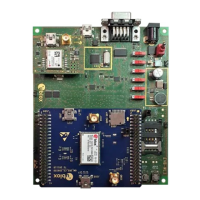SARA-R5 series - System integration manual
UBX-19041356 - R04 System description Page 18 of 118
C1-Public
1.5.1.3 VCC consumption in deep-sleep mode (low power mode and PSM enabled)
The low power mode and the PSM configurations are by default disabled, but they can be enabled
using the +UPSV and +CPSMS AT commands (see the SARA-R5 series AT commands manual [2]).
When low power mode and PSM are enabled, whenever possible the modules automatically enter the
PSM deep-sleep mode (SARA-R500S and SARA-R510M8S modules) or the ultra-low power PSM
deep-sleep mode (SARA-R510S), reducing current consumption down to the lowest steady value: only
the RTC runs with internal 32 kHz reference clock frequency. Detailed current consumption values
can be found in the SARA-R5 series data sheet [1].
1.5.1.4 VCC consumption in low power idle mode (low power mode enabled)
The low power mode configuration is by default disabled, but it can be enabled using the +UPSV AT
command (see the SARA-R5 series AT commands manual [2]).
When low power mode is enabled, the module automatically enters the low power idle mode whenever
possible, but it must periodically monitor the paging channel of the current base station (paging block
reception), in accordance to the LTE system requirements, even if connected mode is not enabled by
the application. When the module monitors the paging channel, it wakes up to the active mode to
enable the reception of the paging block. In between, the module switches to low power mode. This is
known as discontinuous reception (DRX) or extended discontinuous reception (eDRX).
Figure 8 illustrates an example of the module current consumption profile when low power mode
configuration is enabled: the module is registered with the network, automatically enters the low
power idle mode, and periodically wakes up to active mode to monitor the paging channel for the
paging block reception in discontinuous reception (DRX) mode.
Detailed current consumption values can be found in the SARA-R5 series data sheet [1].

